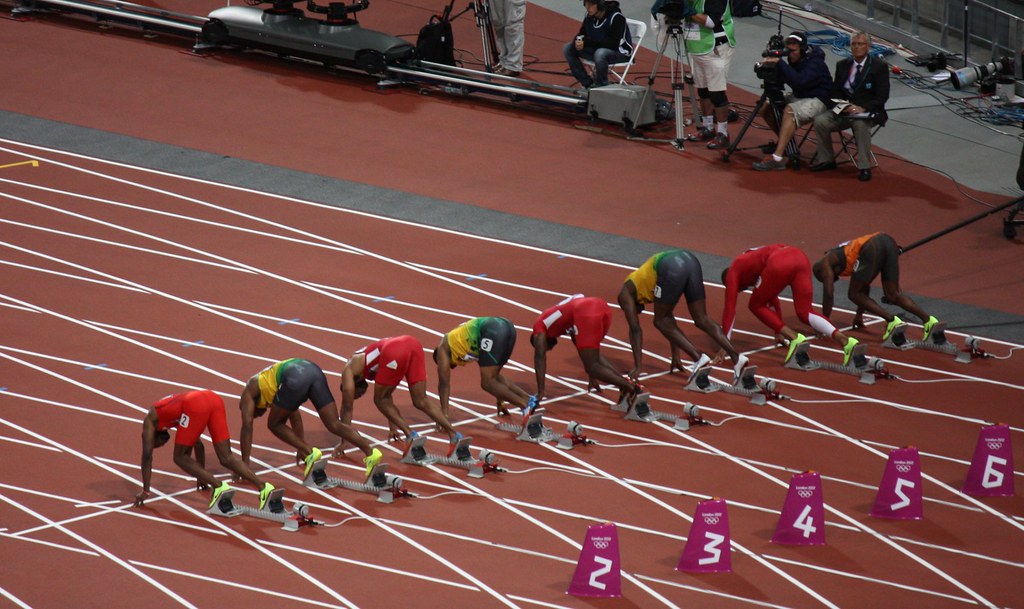
The athlete steadies or replaces the bar during the vault.The athlete moves his lower hand above the upper one or moves the upper hand higher on the pole once he has left the ground.The bar does not remain on the pegs after the vault because it was touched by the athlete.If the pole is broken during the attempt, it isn't considered a failure and the vaulter gets another attempt. The poles may be made of any material and can be of any length and diameter. Athletes may use their own poles during competition. Pole Vault: Athletes are allowed to place a substance on their hands or the pole to obtain a better grip, but are not permitted to use tape on their hands or fingers except to cover an open wound. A failed attempt occurs when the crossbar does not remain on the supports after the jump because it was touched by the athlete. High Jump: Athletes must take off from one foot. Athletes may go over the barriers in any way, as long as no part of the foot or leg falls below the horizontal plane of the top bar at the instance of clearance. Negotiating barriers: In the steeplechase, any competitor who steps to the side of a jump or trails his foot or leg along side any barrier will be disqualified. In the 1500m and steeplechase, there are no lane assignments and runners jockey for position from the start. Lanes: In the 800m, all runners must stay within their assigned lanes through the first turn, after which they break for position to the inside lane. An 800m race comprises eight runners, each in his or her own lane for the staggered start in the 1500m and steeplechase, which have up to 12 runners, a group start is used. The starting command for these races is "On your marks." Once all athletes are at the mark, the Starter's gun is fired, officially starting the race. Start: With all individual races 800m and longer, there are no starting blocks runners begin in an upright position, their hands prohibited from touching the ground.

Negotiating hurdles: Any competitor who trails a foot or leg below the horizontal plane of the top of any hurdle at the instant of clearance will be disqualified. The finish: The first athlete whose torso (as distinguished from the head, neck, arms, legs, hands or feet) reaches the vertical plane of the closest edge of the finish line is the winner. Also, a runner who strays from his or her lane in the straightaway, or crosses the outer line of his or her lane on the bend, and gains no advantage by it, will not be disqualified as long as no other runner is obstructed. If the athlete is forced to run outside of his or her lane by another person, and no material advantage is gained, there will be no disqualification. Any athlete who runs outside the assigned lane is subject to disqualification. The lanes are numbered 1 through 8, starting with the inside lane. Lanes: For all Olympic sprint and hurdle events, runners must remain within their pre-assigned lanes, which measure 1.22 meters (4 feet) wide, from start to finish. The first false start of a race results in an automatic disqualification to the offending runner.

For the 200m, 400m and 400m hurdles, which involve curves, runners are staggered for the start.įalse Starts: If a sprinter commences his or her starting motion from the set position before the Starter's gun is fired, it is deemed a false start. For the 100m, women's 100m hurdles and men's 110m hurdles, all competitors are lined up side-by-side. The starting commands are "On your marks" and "Set." Once all athletes are in the set position, the Starter's gun is fired, officially starting the race. Olympic hurdle and sprint races commence with the firing of the Starter's gun. The starting blocks consist of two adjustable footplates attached to a rigid frame.

Start: Starting blocks are used for all hurdle, relay and sprint events.


 0 kommentar(er)
0 kommentar(er)
